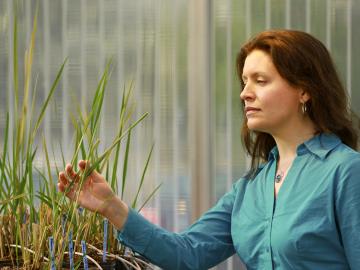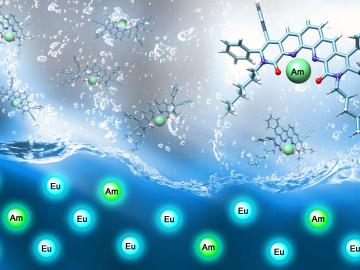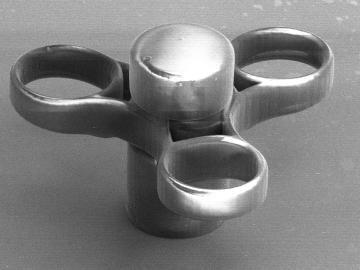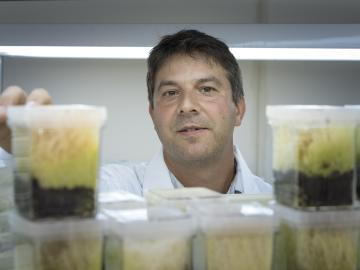
Filter News
Area of Research
- (-) Biology and Environment (102)
- (-) Materials (122)
- Advanced Manufacturing (5)
- Biological Systems (1)
- Biology and Soft Matter (4)
- Building Technologies (2)
- Chemical and Engineering Materials (3)
- Chemistry and Physics at Interfaces (7)
- Clean Energy (168)
- Climate and Environmental Systems (7)
- Computational Biology (1)
- Computational Chemistry (5)
- Computational Engineering (1)
- Computer Science (3)
- Data (1)
- Earth Sciences (1)
- Electricity and Smart Grid (1)
- Energy Frontier Research Centers (7)
- Fuel Cycle Science and Technology (2)
- Functional Materials for Energy (8)
- Fusion and Fission (32)
- Fusion Energy (7)
- Geographic Information Science and Technology (1)
- Isotopes (21)
- Materials for Computing (13)
- Materials Synthesis from Atoms to Systems (8)
- Materials Under Extremes (7)
- National Security (45)
- Neutron Data Analysis and Visualization (2)
- Neutron Science (72)
- Nuclear Science and Technology (27)
- Quantum Condensed Matter (3)
- Quantum information Science (4)
- Renewable Energy (2)
- Sensors and Controls (2)
- Supercomputing (153)
- Transportation Systems (4)
News Type
News Topics
- 3-D Printing/Advanced Manufacturing (5)
- Advanced Reactors (1)
- Artificial Intelligence (8)
- Big Data (8)
- Bioenergy (28)
- Biology (42)
- Biomedical (10)
- Biotechnology (6)
- Buildings (1)
- Chemical Sciences (10)
- Clean Water (10)
- Climate Change (23)
- Composites (3)
- Computer Science (18)
- Coronavirus (5)
- Cybersecurity (1)
- Decarbonization (16)
- Energy Storage (8)
- Environment (63)
- Exascale Computing (5)
- Frontier (3)
- Fusion (2)
- Grid (2)
- High-Performance Computing (13)
- Hydropower (5)
- Isotopes (6)
- Machine Learning (6)
- Materials (20)
- Materials Science (19)
- Mathematics (3)
- Mercury (6)
- Microscopy (13)
- Nanotechnology (10)
- National Security (2)
- Net Zero (1)
- Neutron Science (9)
- Nuclear Energy (9)
- Partnerships (3)
- Physics (12)
- Polymers (5)
- Quantum Computing (1)
- Renewable Energy (1)
- Security (2)
- Simulation (9)
- Space Exploration (1)
- Summit (7)
- Sustainable Energy (19)
- Transformational Challenge Reactor (2)
- Transportation (4)
Media Contacts

A tiny vial of gray powder produced at the Department of Energy’s Oak Ridge National Laboratory is the backbone of a new experiment to study the intense magnetic fields created in nuclear collisions.


“Made in the USA.” That can now be said of the radioactive isotope molybdenum-99 (Mo-99), last made in the United States in the late 1980s. Its short-lived decay product, technetium-99m (Tc-99m), is the most widely used radioisotope in medical diagnostic imaging. Tc-99m is best known ...

Esther Parish’s holistic approach to life is apparent not only in her environmental research at Oak Ridge National Laboratory, but in her careful cultivation of a future crop of young scientists. Her expertise as a geographer coupled with a keen interest in the natural world drives Parish’s resea...


Dan Jacobson is illuminating the workings of biological systems from the molecular scale up by leveraging Oak Ridge National Laboratory’s supercomputing resources to create machine- and deep-learning techniques more easily understood by humans


David Weston became fascinated with plant genetics and ecology in college, and now with the support provided by the DOE Office of Science Early Career Research Program, he will link those fields as he studies plant-microbe symbiosis. The research will focus on sphagnum moss, a dominant plant of n...

Working backwards has moved Josh Michener’s research far forward as he uses evolution and genetics to engineer microbes for better conversion of plants into biofuels and biochemicals. In his work for the BioEnergy Science Center at ORNL, for instance, “we’ve gotten good at engineering microbes th...

Rice University researchers have learned to manipulate two-dimensional materials to design in defects that enhance the materials’ properties. The Rice lab of theoretical physicist Boris Yakobson and colleagues at the Department of Energy’s Oak Ridge National Laboratory are combi...


